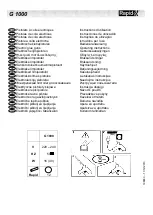
12 ENGLISH
ASSEMBLY
CAUTION:
•
Always remove the fuel cell and the battery car
-
tridge before carrying out any work on the tool.
Loading the nailer
►
Fig.14:
1.
Button
Insert a strip of nails into the slit in the rear of the mag-
azine. The nails stop at the entrance of the magazine
because of the nail stopper. Unlock the magazine by
pressing the button of the nail stopper to insert the nails.
►
Fig.15:
1.
Pusher lever
Pull the pusher lever with pressing the pusher button all the
way to the rear of the magazine. Then release the pusher but
-
ton, and return the pusher lever to the end of the strip gently.
Removing nails
►
Fig.16:
1.
Pusher lever
2.
Nail stopper
Pull the pusher lever and push the pusher button to
release the nail supporter, and then return the pusher
lever to the top with pushing the pusher button.
Slide the nails toward the rear of the magazine. The
nails stop at the entrance of the magazine because of
the nail stopper. Unlock the magazine by pressing the
button of the nail stopper to remove the nails.
Changing the magazine (optional accessory)
►
Fig.17:
1.
Bolt
A magazine with different length is available as optional accessory.
To change the magazine, loosen the bolt and remove the magazine.
Then install the new magazine. And fasten the bolt on the magazine.
OPERATION
WARNING:
•
Do not touch around the exhaust vent.
The surface
will be very hot during or after an operation. Touching
around the exhaust vent may cause burns or injuries.
CAUTION:
•
Make sure all safety systems are in working
order before operation.
Checking proper action before operation
Before operation, always check following points.
— Make sure that the tool does not operate only by
installing the battery cartridge and fuel cell.
— Make sure that the tool does not operate only by
pulling the trigger.
— Make sure that the tool does not operate only by
placing the contact element against the workpiece
without pulling the trigger.
— Make sure that the tool does not operate when
pulling the trigger first and then placing the contact
element against the workpiece.
Driving nails
►
Fig.18
1. To drive a nail, place the contact element against
the workpiece.
The fan motor is activated, fuel gas is injected
into combustion chamber and mixed with air by
the fan.
►
Fig.19:
1.
Trigger
2. Hold the contact element pressing firmly and pull
the trigger.
Fuel gas is combusted and the nail is driven.
3. Further driving can be initiated only after both the
contact element and the trigger are released.
Nail-driving of concrete
WARNING:
•
Use hardened nails only for concrete.
Using other purposed nails may cause serious
injuries. Do not nail directly on the concrete.
Failure to do so may cause concrete fragments
to fly off or nails to strike back, causing serious
injuries.
•
When driving nails, hold the tool so that it stands
upright to the driving surface.
Slanted nail-driving may cause concrete frag-
ments to fly off or nails to strike back, causing
serious injuries.
•
Do not use the tool on the surface that objects
hang from, such as area where hangers for
sewer pipe, dust pipe etc. are set up
CAUTION:
•
Use this tool only for soft concrete built up not
so long before. Using on the hard concrete may
cause nail bending or nail-driving to insufficient
depth.
•
When the penetration amount into concrete is
required more than 20 mm, driving nails to the
sufficient length may not be obtained. Nails may
be driven too shallow causing unstable work
-
piece, resulting in personal injury and damage
to property.
•
When driving nail directly onto hard surfaces
such as steel and concrete, press the contact
element firmly against the workpiece to prevent
slipping.
Choose and use appropriate nails so that the penetra-
tion amount into concrete ranges 15 mm - 20 mm.
►
Fig.20:
1.
Thin steel plate
2.
Penetration amount
into concrete
Anti dry fire mechanism
This mechanism prevents the tool from firing without
nail.
Dry fire prevention automatically functions when the
rest of nails get to the last 2-3 pieces.
Summary of Contents for GN420CLZK
Page 2: ...2 1 2 3 4 5 6 7 8 9 10 Fig 1 1 1 2 1 1 2 Fig 2 Fig 3 Fig 4 Fig 5 Fig 6 Fig 7 ...
Page 3: ...3 1 1 1 1 1 Fig 8 Fig 9 Fig 10 Fig 11 Fig 12 Fig 13 Fig 14 Fig 15 ...
Page 4: ...4 1 2 1 1 Fig 19 1 2 1 Fig 16 Fig 17 Fig 18 Fig 20 Fig 21 ...
Page 5: ...5 1 2 1 1 2 Fig 22 Fig 23 Fig 24 Fig 25 Fig 26 ...













































